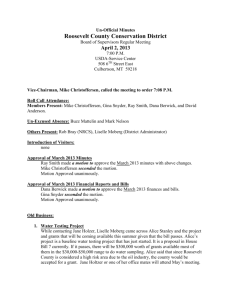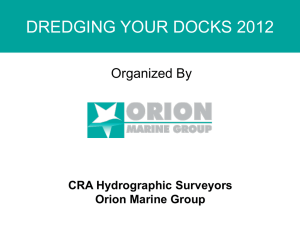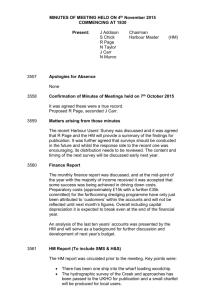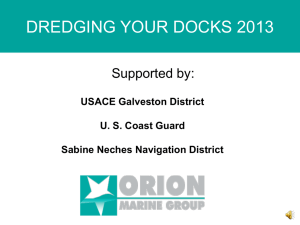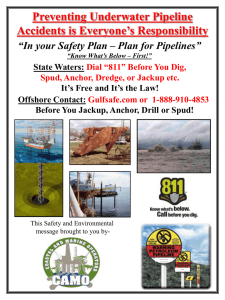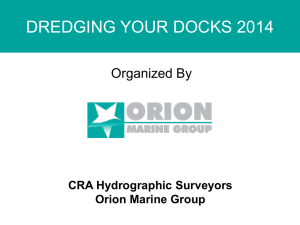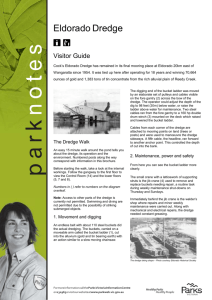Suction Dredging Techniques
advertisement
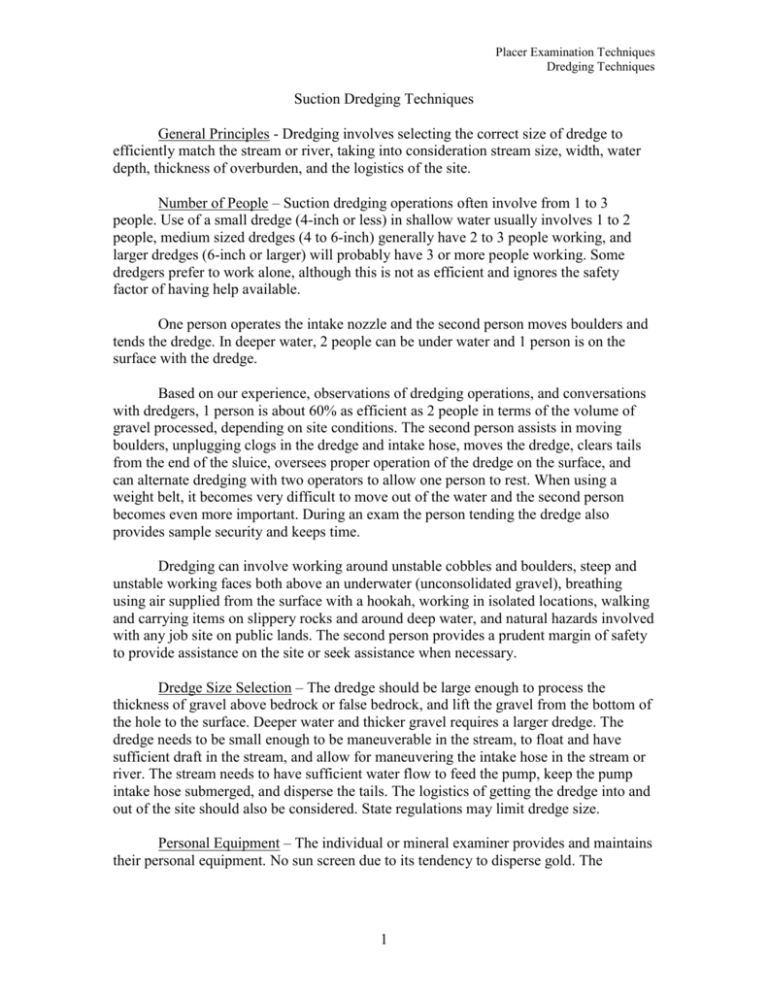
Placer Examination Techniques Dredging Techniques Suction Dredging Techniques General Principles - Dredging involves selecting the correct size of dredge to efficiently match the stream or river, taking into consideration stream size, width, water depth, thickness of overburden, and the logistics of the site. Number of People – Suction dredging operations often involve from 1 to 3 people. Use of a small dredge (4-inch or less) in shallow water usually involves 1 to 2 people, medium sized dredges (4 to 6-inch) generally have 2 to 3 people working, and larger dredges (6-inch or larger) will probably have 3 or more people working. Some dredgers prefer to work alone, although this is not as efficient and ignores the safety factor of having help available. One person operates the intake nozzle and the second person moves boulders and tends the dredge. In deeper water, 2 people can be under water and 1 person is on the surface with the dredge. Based on our experience, observations of dredging operations, and conversations with dredgers, 1 person is about 60% as efficient as 2 people in terms of the volume of gravel processed, depending on site conditions. The second person assists in moving boulders, unplugging clogs in the dredge and intake hose, moves the dredge, clears tails from the end of the sluice, oversees proper operation of the dredge on the surface, and can alternate dredging with two operators to allow one person to rest. When using a weight belt, it becomes very difficult to move out of the water and the second person becomes even more important. During an exam the person tending the dredge also provides sample security and keeps time. Dredging can involve working around unstable cobbles and boulders, steep and unstable working faces both above an underwater (unconsolidated gravel), breathing using air supplied from the surface with a hookah, working in isolated locations, walking and carrying items on slippery rocks and around deep water, and natural hazards involved with any job site on public lands. The second person provides a prudent margin of safety to provide assistance on the site or seek assistance when necessary. Dredge Size Selection – The dredge should be large enough to process the thickness of gravel above bedrock or false bedrock, and lift the gravel from the bottom of the hole to the surface. Deeper water and thicker gravel requires a larger dredge. The dredge needs to be small enough to be maneuverable in the stream, to float and have sufficient draft in the stream, and allow for maneuvering the intake hose in the stream or river. The stream needs to have sufficient water flow to feed the pump, keep the pump intake hose submerged, and disperse the tails. The logistics of getting the dredge into and out of the site should also be considered. State regulations may limit dredge size. Personal Equipment – The individual or mineral examiner provides and maintains their personal equipment. No sun screen due to its tendency to disperse gold. The 1 Placer Examination Techniques Dredging Techniques following items are usually necessary to conduct a suction dredge exam, in addition to the dredge: 1. Wet suits (tops, bottoms and hoods) are generally necessary when dredging in water that is more than 1 to 2 feet deep since the person operating the intake nozzle can work more efficiently when lying in the water. Water depth plus depth of gravel often results in dredge holes that are 3 or 4 feet deep even when operating a small dredge; 2. Face mask and snorkel; 3. Gloves for gripping and moving rocks, and possibly for warmth. Orange gloves help to keep the hands visible underwater; 4. Boots or shoes to wear underwater for protection and traction, ankle protection is important and toes have a tendency to get pinched between rocks; 5. Knee pads since much time is spent on knees on rocks; 6. Weight belts are necessary when working in water over three feet deep. 7. Waterproof watch. Tools – Dredge operations require numerous hand tools. It is very helpful to paint all hand tools a bright or fluorescent orange, which helps in finding tools underwater and preventing loss. Tools useful in suction dredge exams include: 1. Small and medium sized pry bars or crow bars, 1 to 2 feet long; 2. Long breaker bar to move boulders; 3. Come-alongs or winches and cables to move and stabilize boulders; 4. Shovels and rakes to disperse tails; 5. Rubber mallet to unclog intake hose; 6. Buckets and tubs to carry water, contain concentrates, act as a safety pan; 7. Rope to secure and move dredge; 8. Suction devices (turkey baster) to clean out crevices or suck up pieces of gold. Develop a working face – If a dredge hole and working face has not already been excavated, the dredger needs to open a hole and develop a working face in the gravel. 2 Placer Examination Techniques Dredging Techniques 1. After the site is selected, move boulders and other oversized debris so that the dredger does not have to move these items and these items do not fall or roll back into the hole. Move this oversize material to the side or behind so they do not have to be moved again. 2. Develop a hole that is large enough for the dredger to maneuver in with the intake hose, and that allows sufficient water to flow through and clear out suspended sediments to improve visibility. 3. Work the intake nozzle to move the working face upstream when possible. 4. Clean out all fractures and joints and behind any rock overhangs, use hand tools to pry loose any material in potential gold traps. Dredge along these structures whenever possible. 5. Break up and clean off the bedrock surface using hand tools. 6. Break up clay balls and consolidated gravel before sending them through the dredge, or have person tending the dredge watch for clay balls or consolidated gravel. 7. Place boulders and oversize material to the side or in the hole behind (downstream of) the dredger to prevent them from rolling back into the hole or not allowing water to flow through the hole. 8. Feed gravel into the intake hose in a controlled and consistent manner. Try to remove rocks that may cause plugs (flat, angular, long, or only slightly smaller than the intake hose) before they get into the intake hose. 9. Observe the material being dredged and any surfaces or structures to check for gold. Pick out and save any coarse pieces of gold seen in the gravel. Air Supply – Air is usually supplied either via snorkel when water depths are shallow and gravel is not thick or through a hookah for deeper water. Snorkels allow for greater maneuverability and eliminate the need for air lines interfering with work. Hookahs are generally necessary when working more than about 3 feet below the surface. Hookahs require additional equipment and air lines, but allow the dredger to remain on the bottom of the gravels with the intake nozzle without having to return to the surface several times per minute. The dredge must be equipped with a compressor to supply air. Weight belts are necessary when working at water depths that require supplied air. Safety – Dredging involves working in several different types of potentially hazardous conditions, including: 1. Work submerged in water, often in cold, fast flowing water; 3 Placer Examination Techniques Dredging Techniques 2. Working under and next to large, heavy and unstable objects underwater and above the dredger on the surface, such as boulders, stumps, gravel embankments; 3. Working underwater in conditions of limited visibility due to murky water and limited peripheral vision from goggles; 4. Moving, handling and carrying large heavy objects such as rock, dredge parts, engines on slippery rocks and around deep water; 5. Depending on air supplied from the surface; 6. Extended periods in cold water; 7. Working in possible contaminated water; 8. Using hand tools in conditions of limited visibility. Government agencies or units may have specific safety policies regarding suction dredging. The Forest Service in California requires open diver certification. 4
